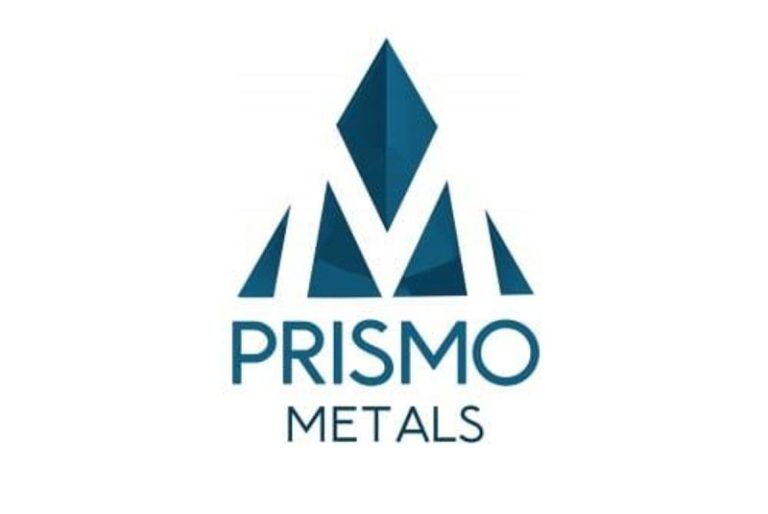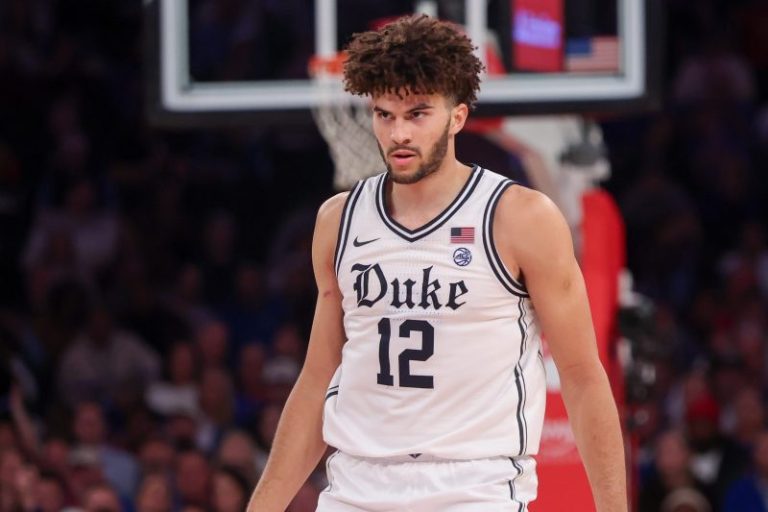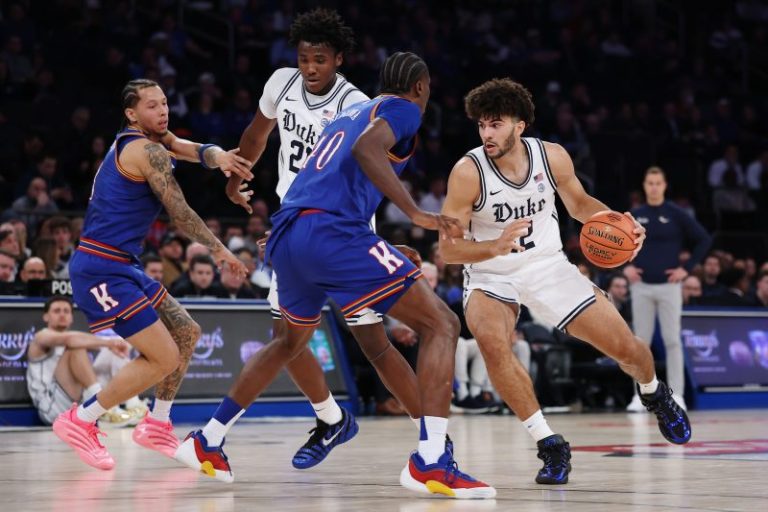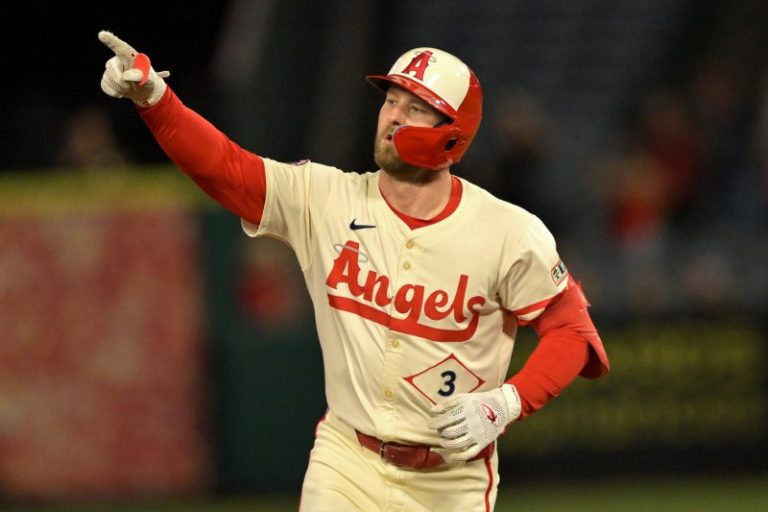NEW YORK — At a time of the calendar year when college football typically commands sports fans’ attention, the men’s college basketball world won the night at Madison Square Garden with the Champions Classic.
The annual doubleheader clash between four of the sport’s biggest blue bloods — Duke, Kansas, Kentucky and Michigan State — once again served as the unofficial kickoff event of the college basketball season with some of the sport’s top talent under the same roof on a Tuesday night in November.
The first of those games came with a clash between Tom Izzo’s Michigan State Spartans and Mark Pope’s Kentucky Wildcats, one that the 18th-ranked Spartans dominated in thanks to a big night from Jaxon Kohler and their ability to find their 3-point game.
Then, in the nightcap, Cameron Boozer helped No. 4 Duke defeat No. 23 Kansas, which was without star freshman Darryn Peterson.
With their wins, the Spartans improved their Champions Classic overall record to 6-9, while the Blue Devils moved to 9-6 in the event, which was back at ‘The World’s Most Famous Arena’ for the first time since 2019. Meanwhile, with their losses, Kentucky dropped to 6-9 and Kansas dropped to 9-6.
Here are a few takeaways from The Garden:
Cameron Boozer delivers in MSG debut
For many, the annual Champions Classic doubleheader not only serves as the ‘official’ start of the college basketball season, since some of the top programs in the country are all under one roof, but it also provides the first opportunity for fans to watch some of the top players in the country on the same floor.
One of those players is Boozer, the No. 3 recruit in the 2025 recruiting class and son of longtime NBA player Carlos Boozer. In his MSG debut, Boozer finished with a double-double of 18 points and 10 rebounds.
‘I still don’t think he played incredible. That’s the thing that’s really exciting,’ Duke head coach Jon Scheyer said on Boozer’s debut at The Garden.
‘He made some key plays, like the rebound in the first half, the outlet to Isaiah. I thought he did a great job putting pressure on the defense. … This place is different. Playing MSG, it’s different. I thought he did a really good job handling that.’
Kansas kept Boozer quiet in the first half from a scoring standpoint, as he finished with just seven points on 2-of-6 field goal attempts in the opening 20 minutes. That still didn’t stop him from impacting the game with his play-making abilities. Case in point: his full-court pass near the end of the first half to Isaiah Evans.
Similar to Duke’s opening game against Texas in the Dick Vitale Invitational, Boozer found his stride in the second half. He added 11 points in the second half alone, including a tough finish at the basket that drew a foul after the ball went in.
Kansas coach Bill Self said he thought his team defended Boozer ‘pretty well.’
‘I thought we did some good things. I think these guys would probably agree with me, when we screwed up, it seemed like he made us pay when we screwed up,’ Self said. ‘If you miss a block out he’ll make you pay on the block out. If we screwed up, which we did a few times … He’ll make you pay out of that.’
He then pointed to Boozer’s passing ability as something that stood out to him as well. He finished with five assists on the night.
‘He does a lot of things well, but he’s a really good passer,’ Self said. ‘I felt pretty good about how our guys defended (him), even in 1-on-1 type situations. But when we screwed up, he took advantage of it.’
Boozer’s big night at The Garden helped Duke to its ninth consecutive win at ‘The World’s Most Famous Arena,’ and the program’s 10th in its last 11 trips to what is commonly referred to as ‘Cameron North,’ a nickname given out by its fanbase with Duke having played at least one game at Madison Square Garden in 25 of the last 28 seasons.
Jaxon Kohler puts together big night as Michigan State finds 3-point shooting identity
Kohler set the tone on offense for the Spartans with an early 3-pointer in the game’s opening minutes, a ‘confidence’ booster of a shot that served to be an early sign of what would come against Kentucky from the senior 6-foot-9 forward.
‘After last game, I didn’t make one three. In the moment, it pissed me off and motivated me, but the next day, it didn’t affect my confidence because I know that I put the work in and I know how many shots I put up,’ Kohler said after the game in the Spartans locker room. ‘… Confidence is the biggest thing.’
The veteran forward showed a strong presence on the floor throughout his 27 minutes of action, as he was able to impact the game by controlling the entire offensive end with layups, mid-range shots and 3-pointers. He’d finished the night with a season-high 20 points on 8-of-12 shooting, five rebounds and a block.
‘Jaxon’s gonna make plays,’ Michigan State guard Jeremey Fears Jr. said of Kohler. ‘I think he’s been a lot better passing out of the post … He’s hard to guard. He’s gonna fight off the rebounds. He’s gonna run the lane, he’s gonna match a catch and shoot. He’s gonna post up.
‘… I love that he’s on my team for sure.’
Kohler’s night punctuated Michigan State’s ability to find its 3-point shooting identity, a part of the Spartans’ game they aren’t known to win games with under Izzo. The Spartans’ identity in 31 seasons with Izzo, of course, has been their ability to win games by dominating the glass.
That isn’t to say Michigan State wasn’t able to gobble up rebounds. The Spartans out-rebounded Kentucky 42-28 on the night, including a 10-6 advantage on the offensive glass.
Even so, it was Michigan State did outside of its normal game that won the night.
The Spartans hit seven 3s in the first half to build a 44-27 halftime lead, with four of them coming before the first media timeout at the 13:15 mark of the half. That sharp shooting continued in the second half with four made triples in the final 20 minutes alone.
To emphasize how uncharacteristic of a night the Spartans had from beyond the arc, they entered the night with a 3-point shooting percentage (21.7%) that ranked 352nd in the country.
‘You know, I told my wife, I told my AD, I told my staff, we had three of the best days of practice. We went at it,’ Izzo said after the game. ‘We had two-a-days one day. I don’t know, that’s probably illegal now, I don’t know. But since there’s no laws and rules — right, since there is none, it doesn’t really matter, but we did.
‘I think when you get players to the point where they realize the work is beneficial for them and us, and that’s what wins like tonight will do. Maintaining that, there are 27, 26 games left, so don’t — as my buddy (former Alabama coach) Nick (Saban) says, don’t throw rat poison at me, but we deserve to feel good for a night because we weren’t great other than our shooting early.’
Kentucky unable to find a rhythm on offense
While Michigan State had an above-average night offensively, Kentucky did not.
‘We’re really disappointed, and we’ve got a lot of work to do,’ Pope said of Kentucky’s overall performance.
It didn’t start all that bad for the Wildcats. They traded early punches with the Spartans and even held a 17-14 lead at the first media timeout. The teams traded the lead seven times in the opening seven minutes.
It was out of the media timeout when things began to go downhill for Kentucky, which is expected to compete in the SEC in Pope’s second season. Down two starters in Jaland Lowe and Jayden Quaintance and continuing to find its identity after adding numerous players from the transfer portal, the Wildcats were unable to keep up with the Spartans’ hot shooting as they underwent multiple cold stretches.
A 27.6% field goal shooting percentage combined with seven 3-pointers given up to Michigan State had Kentucky down 44-27 at halftime.
‘We just played poor. It was poor, poor attention to detail on the defensive end,’ Pope said.
Pope’s squad would show some life early on in the second half, even making it a 10-point game at the 9:37 mark, which forced Izzo to call a timeout. The Wildcats wouldn’t be able to keep that offensive momentum, as they fell back into an offensive slump and Michigan State built its lead back up thanks to the efforts of Kohler and freshman guard Cam Ward.
The Wildcats ended the night hitting just two of their final 10 field goal attempts, one of which was a three from Jasper Johnson with 30 seconds remaining in the game. And if that wasn’t alarming enough, Kentucky finished with just 14 assists on 20 made field goals on the night, which was one more assist than Fears finished with by himself for Michigan State.
‘I’ve got to do a better job. My messaging is not resonating with the guys right now. That’s my responsibility,’ Pope said. ‘We’re not playing like our teams play, and that’s my communication issue, so that’s a place we’ve got to work.
Kansas shows depth with Darryn Peterson out
Kansas found itself a man down entering the night, with Peterson being ruled out due to an ongoing hamstring strain. That still didn’t deter Bill Self’s program from giving the Blue Devils — who are expected to make another run at the ACC title in the Men’s NCAA Tournament — a close game.
A reason the Jayhawks were close to picking up their signature early-season win was their ability to rely on their depth. Kansas is now 0-2 on the season against top-25 ranked opponents, with the other loss coming to No. 19 UNC in Chapel Hill in the first week of the season.
One player who stepped up in Peterson’s absence was Flory Bidunga, who is off to a strong second season after an underwhelming freshman campaign. The Jayhawks’ 6-foot-10 forward finished with 14 points, six rebounds and an assist on the night despite being in foul trouble.
‘He’s gotten a lot better,’ Self said on Bidunga’s development. ‘The thing about Flow (Bidunga) is, to me, is he could play really well and not score because he’s so active. He can change the game with activity. His offensive game has gotten better. And I thought he played big tonight and he played athletic.’
Champions Classic 2025 scores
Here’s a breakdown of the scores from the 15th edition of the Champions Classic on Nov. 18:
- Game 1:No. 18 Michigan State 83, No. 13 Kentucky 66
- Game 2:No. 4 Duke 78, No. 23 Kansas 66
The USA TODAY app gets you to the heart of the news fast. Download for award-winning coverage, crosswords, audio storytelling, the eNewspaper and more.
This post appeared first on USA TODAY










